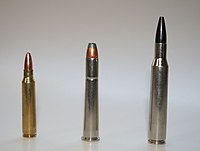.32-40 Ballard
| .32-40 Ballard | ||||||||||||||||||||
|---|---|---|---|---|---|---|---|---|---|---|---|---|---|---|---|---|---|---|---|---|
 .32-40 cartridge between .223 Remington (left) and .270 Winchester (right) | ||||||||||||||||||||
| Type | Rifle | |||||||||||||||||||
| Place of origin | USA | |||||||||||||||||||
| Specifications | ||||||||||||||||||||
| Case type | Rimmed, straight | |||||||||||||||||||
| Bullet diameter | .320 in (8.1 mm) | |||||||||||||||||||
| Neck diameter | .338 in (8.6 mm) | |||||||||||||||||||
| Base diameter | .424 in (10.8 mm) | |||||||||||||||||||
| Rim diameter | .506 in (12.9 mm) | |||||||||||||||||||
| Rim thickness | .063 in (1.6 mm) | |||||||||||||||||||
| Case length | 2.13 in (54 mm) | |||||||||||||||||||
| Overall length | 2.59 in (66 mm) | |||||||||||||||||||
| Rifling twist | 1 in 16 in (410 mm) | |||||||||||||||||||
| Primer type | Large rifle | |||||||||||||||||||
| Ballistic performance | ||||||||||||||||||||
| ||||||||||||||||||||
| Test barrel length: 20 inches (510 mm) | ||||||||||||||||||||
The .32-40 Ballard (also called .32-40 Winchester)[1] is an American rifle cartridge.
Description
Introduced in 1884, the .32-40 was developed as a black powder match-grade round for the Ballard single-shot Union Hill Nos. 8 and 9 target rifles. Using a 165-grain (10.7 g) bullet and 40 grains (2.6 g) of black powder (muzzle velocity 1,440 ft/s (440 m/s), muzzle energy 760 ft⋅lbf (1,030 J)), the factory load gained a reputation for fine accuracy, with a midrange trajectory of 11 inches (28 cm) at 200 yd (180 m).[2] It was available in Winchester and Marlin lever-action rifles beginning in 1886.[2] It and the .38-55 were chambered for the Model 1894 Winchester when it came out in 1894.[3] It stopped being a factory chambering around 1940.[2]
It can be used for varmint and predator hunting, including coyotes and wolves. H. V. Stent has said that for a time the .32-40 and .38-55 were considered by some hunters to be usable for moose and elk at woods ranges, but sales of the Model 1894 in 30 WCF (.30-30), a cartridge introduced a year later, soon outpaced the two because of its higher speed, higher energy, and flatter trajectory.[4]
More recently, the .32-40 in a Model 1894 built in 1905 was successfully used by John Royer, from Pennsylvania, to show that it can still be used on whitetail deer at close range. He wanted to keep the shot within 75 yards.[5] The range at which the .32-40 is suitable for deer is a matter of debate. Its common muzzle energy of <800 ft-lb is equal only to current 150 and 170 grain flat- or round-nose loadings of the .30-30 (in a 20-in barrel) at about 200 yards, which is often considered to be the maximum range of the .30-30.[6] However, it has been said that in a modern rifle it can be loaded to equal the .30-30 up to 300 yards (270 m).[2]
The .32-40 also served as the basis for Harry Pope's wildcat .33-40.
See also
References
- ^ Barnes, Frank C., ed. by John T. Amber. Cartridges of the World (Northfield, IL: DBI Books, 1972), p.67.
- ^ a b c d Barnes, p.47.
- ^ H. V. Stent, "The Model 94 Winchester," Gun Digest 1980.
- ^ H. V. Stent, "The Model 94 Winchester," Gun Digest 1980.
- ^ See Leatherwood Outdoors website for a video of an antlerless deer taken with a handload.
- ^ Grits Gresham, "The .30/30," Sports Afield August 1980. Gresham says PMC tested the MV of its 150- and 170 grain .30-30 loads from a Model 94 carbine, which resulted in a reading of just under 2000 fps, resulting in about 800 fpe at 200 yards.
Sources
- Barnes, Frank C., ed. by John T. Amber. Cartridges of the World (Northfield, IL: DBI Books, 1972),